This text was obtained via automated optical character recognition.
It has not been edited and may therefore contain several errors.
) through the formal training of reviews and garrison maneuvers, they evinced on this memorable night, that enthusiasm, patriotism, and a sense of a just cause, which were of far more avail than scientific tactics. The heroes of Wellington, who boasted of their military tactics and disciplined valor, were often doomed by woful (sic) experience, to appreciate the prowess of those warlike sons of the western country. 26 V Both armies now began in earnest to prepare for the impending big battle. The British ferried in several thousand more soldiers, bringing their number to approximately 8,000. General Sir Edward M. Pakenham, the Duke of Wellington?s brother-inlaw, arrived on Christmas Day eager to add other laurels to his 22-year military career. His accomplishments already included his decisive attack as division commander at Salamanca in the Peninsula Campaign against Napoleon. Jackson, although elated over the results of the initial encounter, realized that the British had come to fight, not as a striking force similar to that of the Washington foray, but as a conquering army bent upon seizing the Mississippi Valley. When, early in the morning of December 24, there was no move by the invaders, Jackson drew his army back about two miles to a point between the McCarty and Chalmette plantations and formed a line which extended from the Mississippi River on his right to a cypress swamp on the left.27 The Rodriguez Canal, a large wet ditch five feet deep, ran in front of the works. There the soldiers worked feverishly day and night to erect strong breastworks. Carroll?s position was on an extension of the canal. Coffee, on the extreme left of Jackson?s 24 ) ) line after a scare on December 28, extended his ditch and works into the swamp, eliminating almost and further possibility for a flanking attack. The entire line covered about three-quarters of a mile, with about two-thirds of this being across the open plain. Although no general action ensued immediately after the night battle, conditions in the battlefield area were hardly tranquil prior to January 8. On the evening of December 27, the British rushed a strong force forward, causing Jackson?s advance guard to fall back under heavy cannon, rocket, and musket fire. Pakenham staged a reconnaissance in force the next day and before it was called off the British were able to install a sizable force behind a fence oblique to the American line. Carroll instructed Colonel James Henderson and a detachment of 200 men to sweep along a wooded area, make a turn to the right toward the river and thus cut off the Redcoats. Unfortunately, Henderson?s slant to the right was premature and left the British still well covered by the fence, and his detachment several yards away from the protective covering of the woods.28 A burst of musketry killed Henderson and five men and the others fell back into the woods. In the noisy and heavy artillery duel of January 1, casualties on each side were few, but the Americans at the guns proved as keen marksmen as the Tennessee riflemen, and impressed the British considerably. The British sentries were indeed terrified by the Tennesseans? ability with their rifles. These sentries called the Tennesseans dirty shirts because their brown hunting dress camouflaged them in the thick undergrowth and dry grass. These militiamen were not soldiers in the European definition 25

Battle of 1814 25